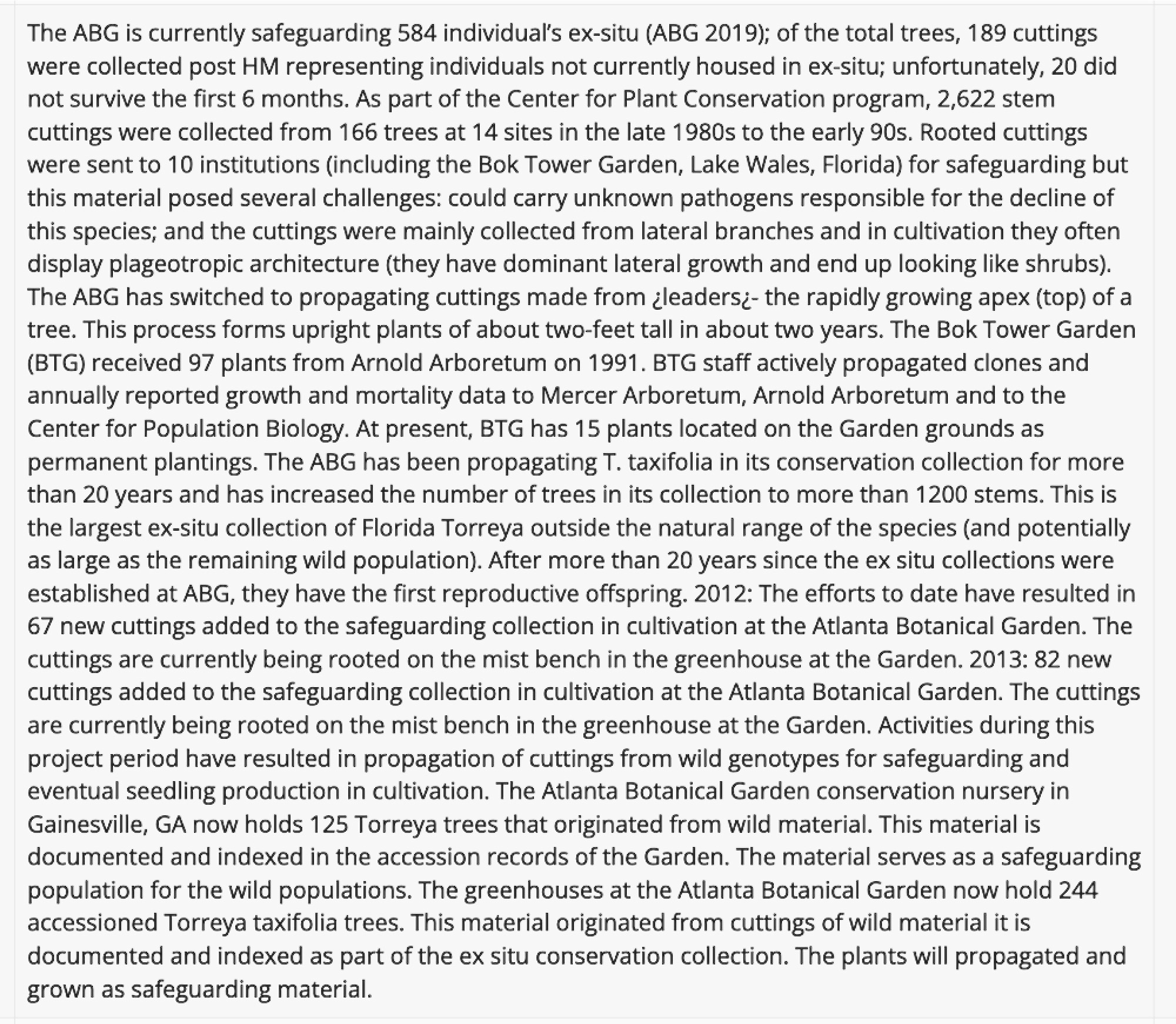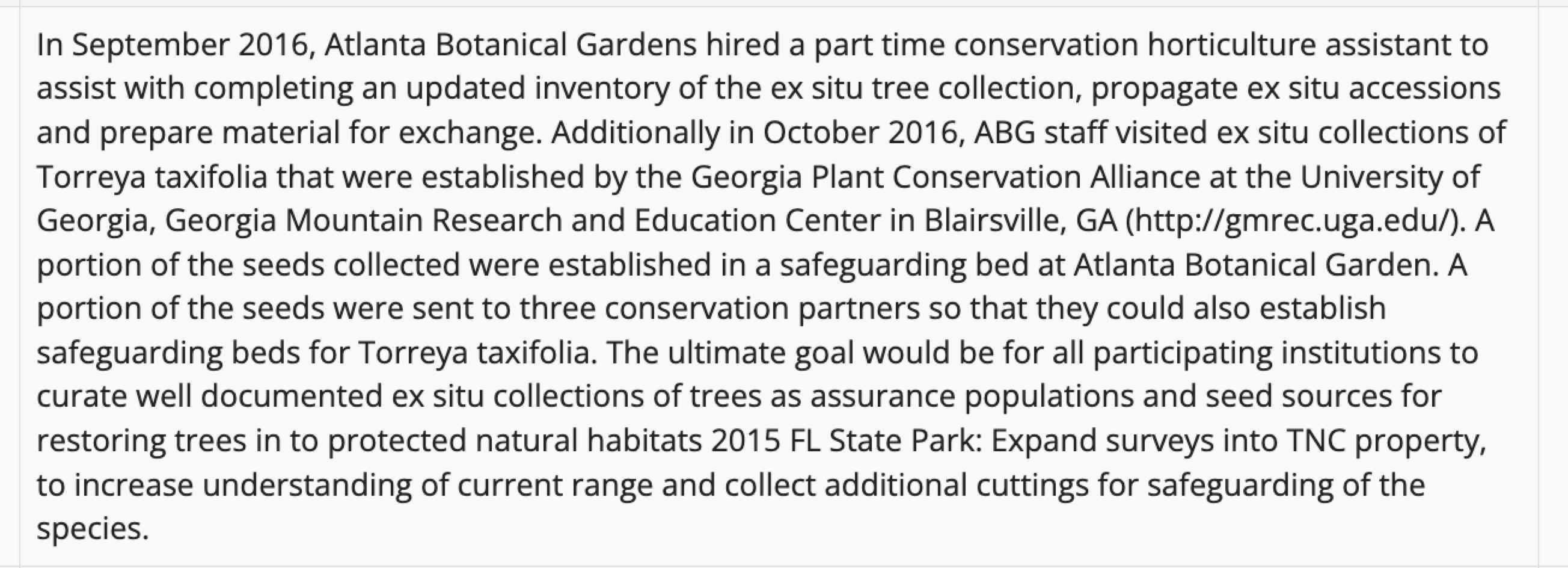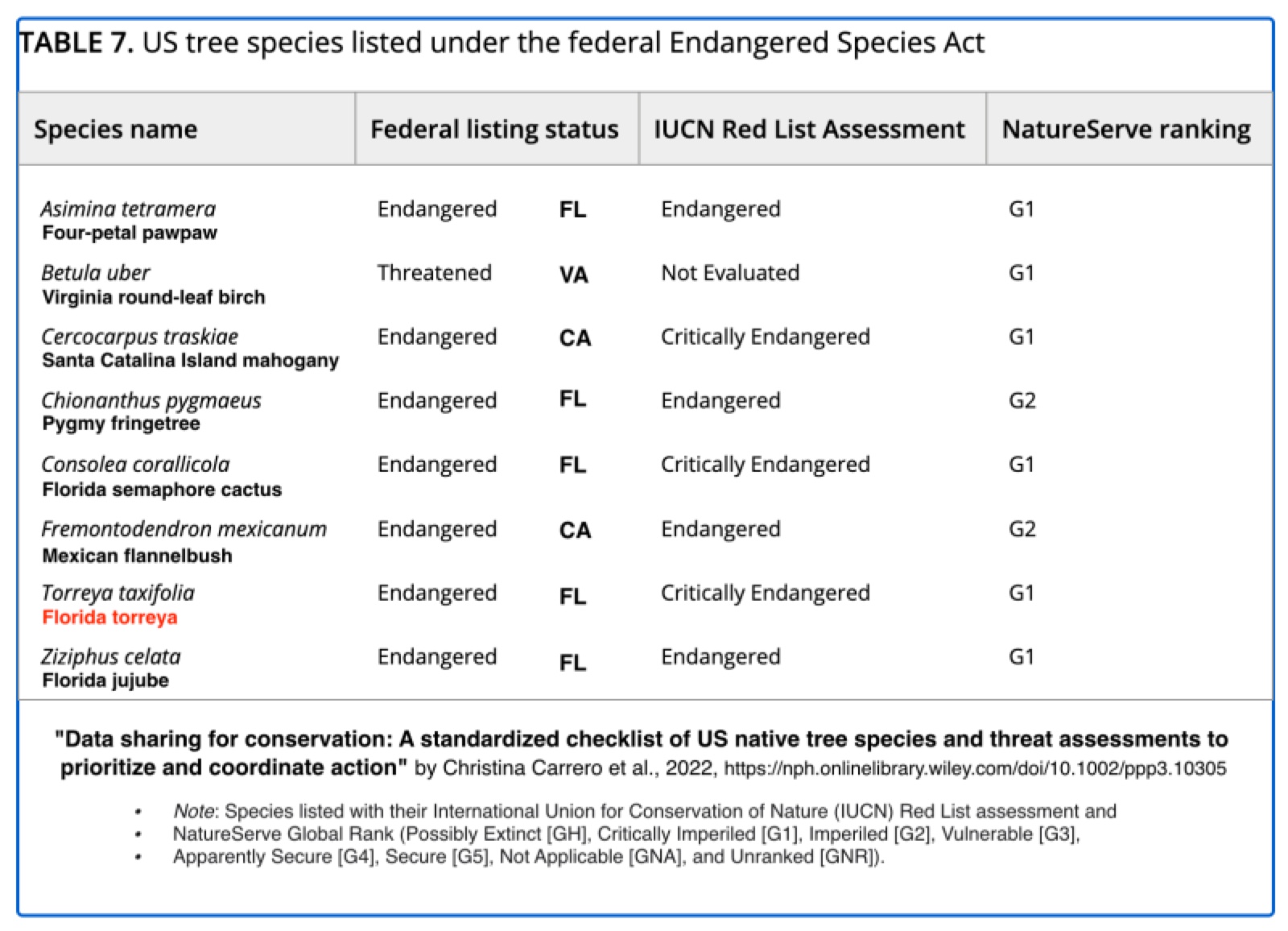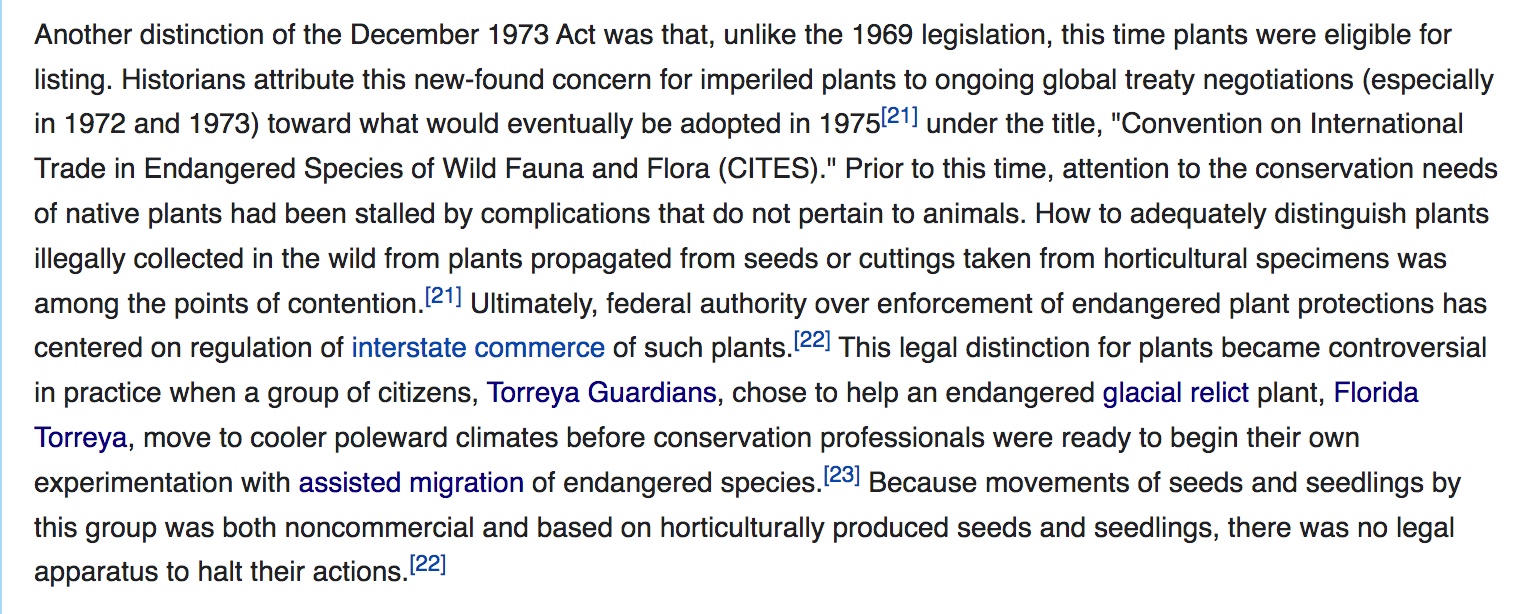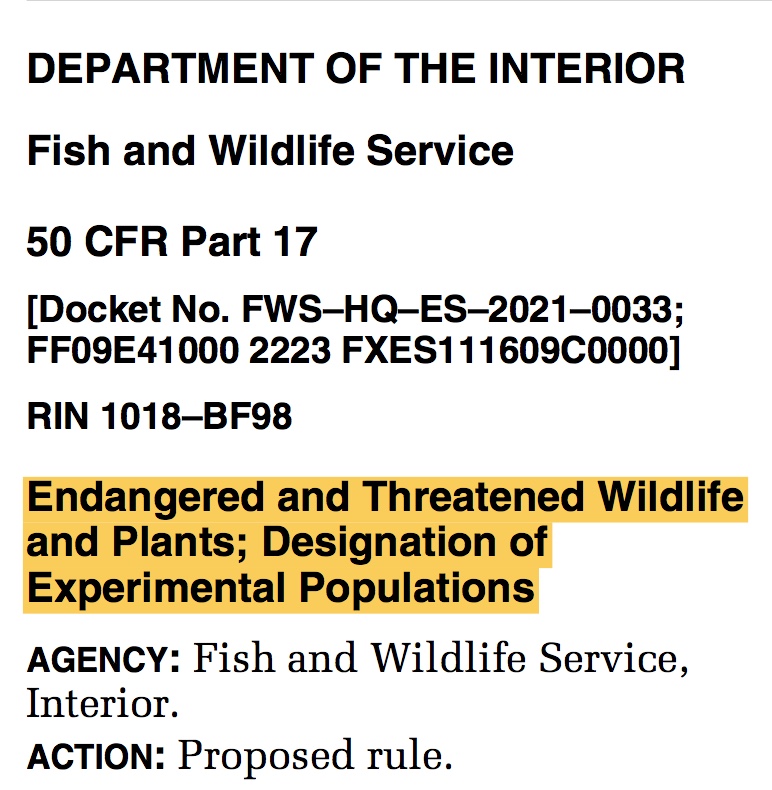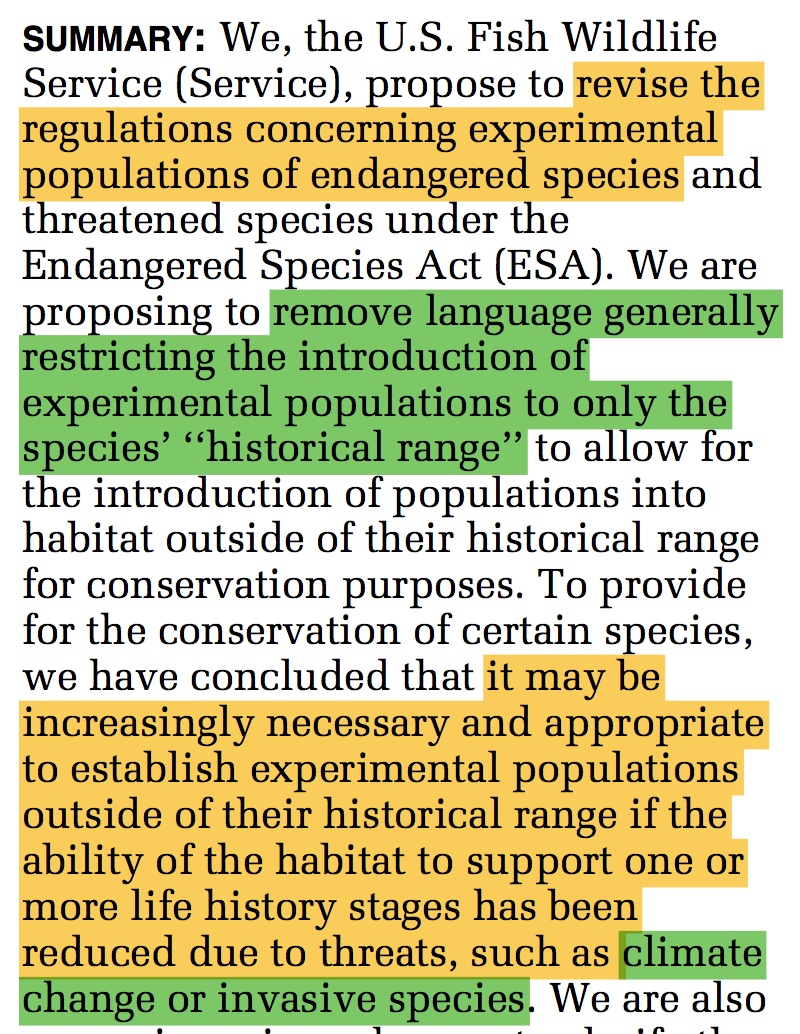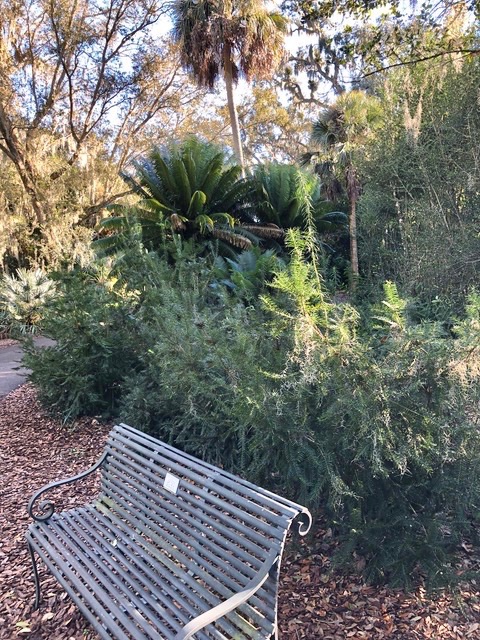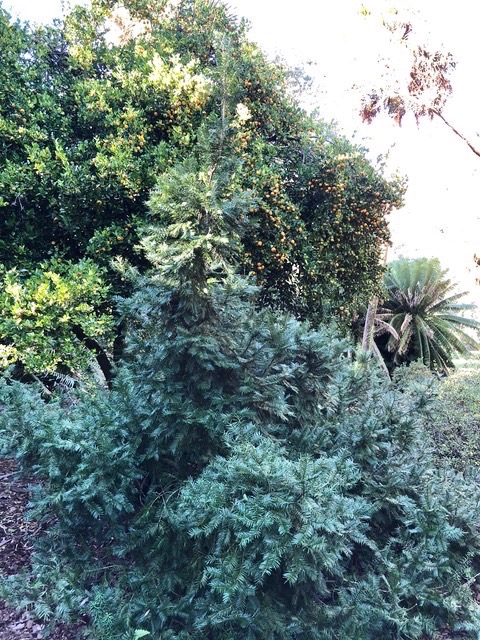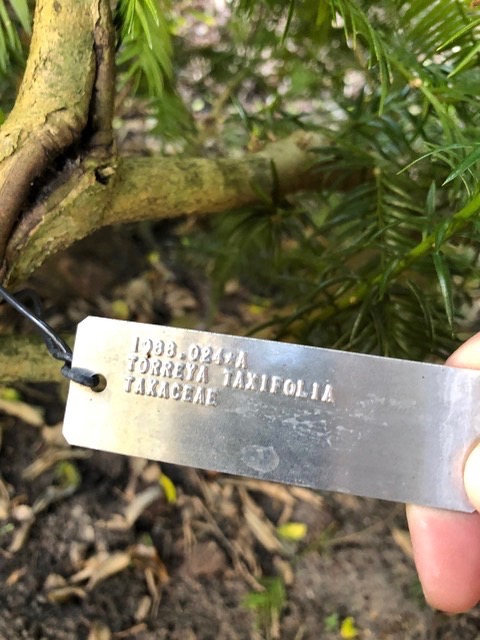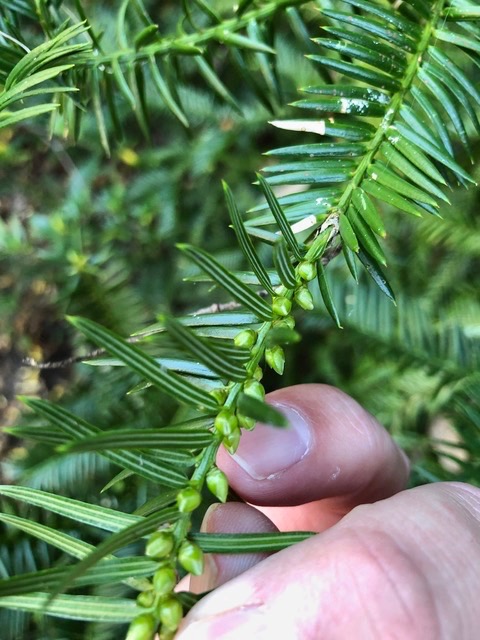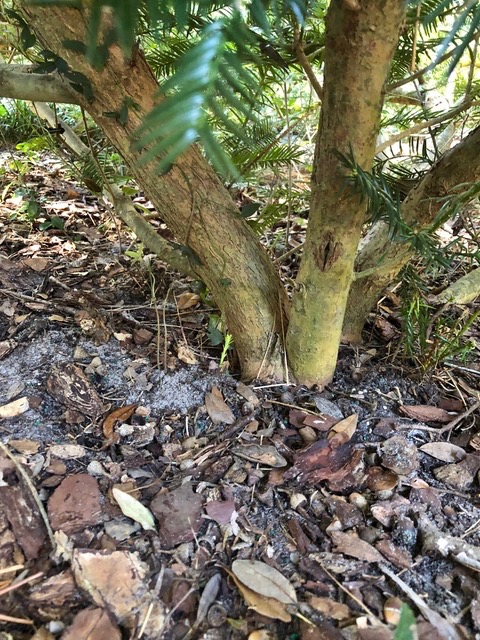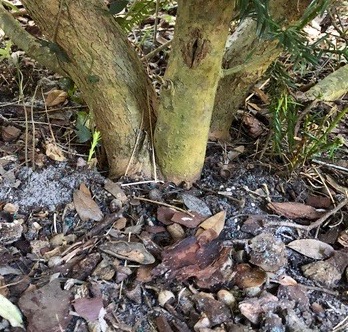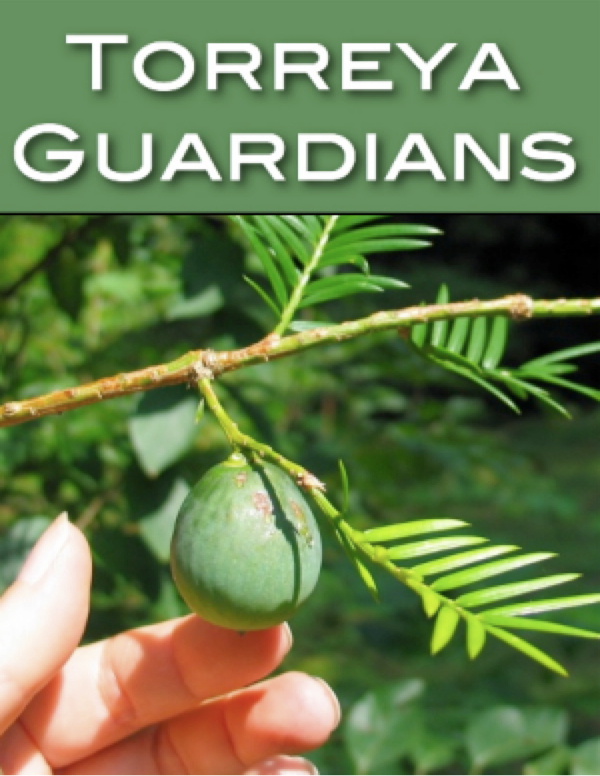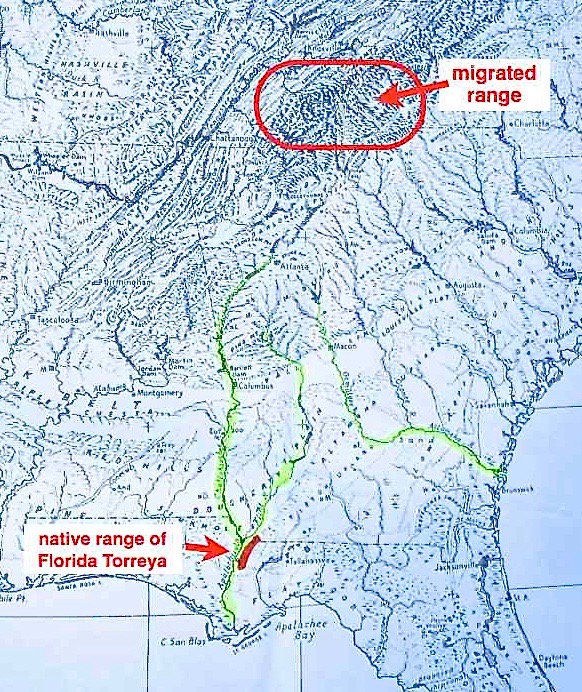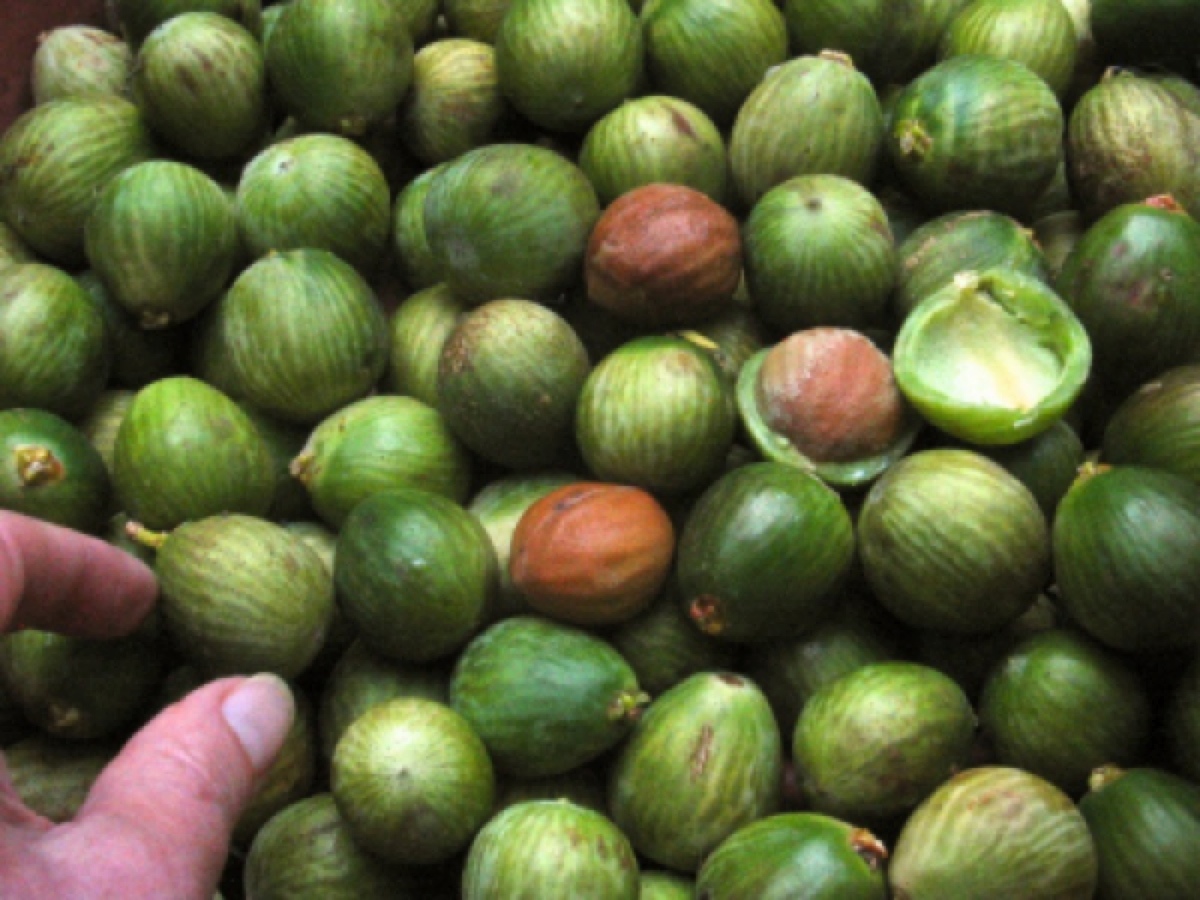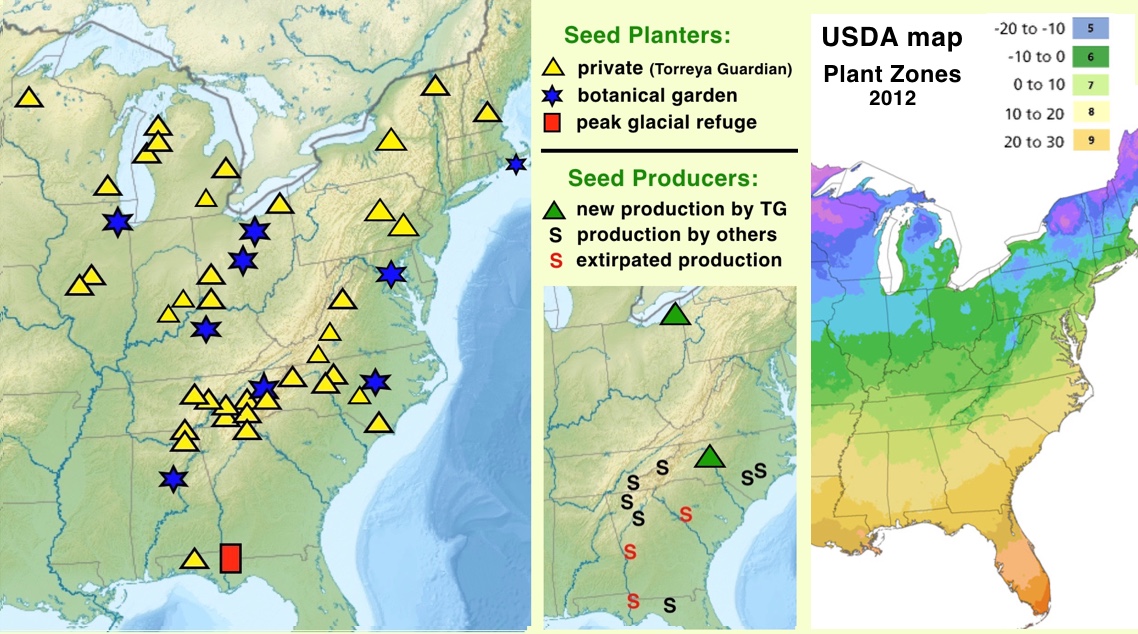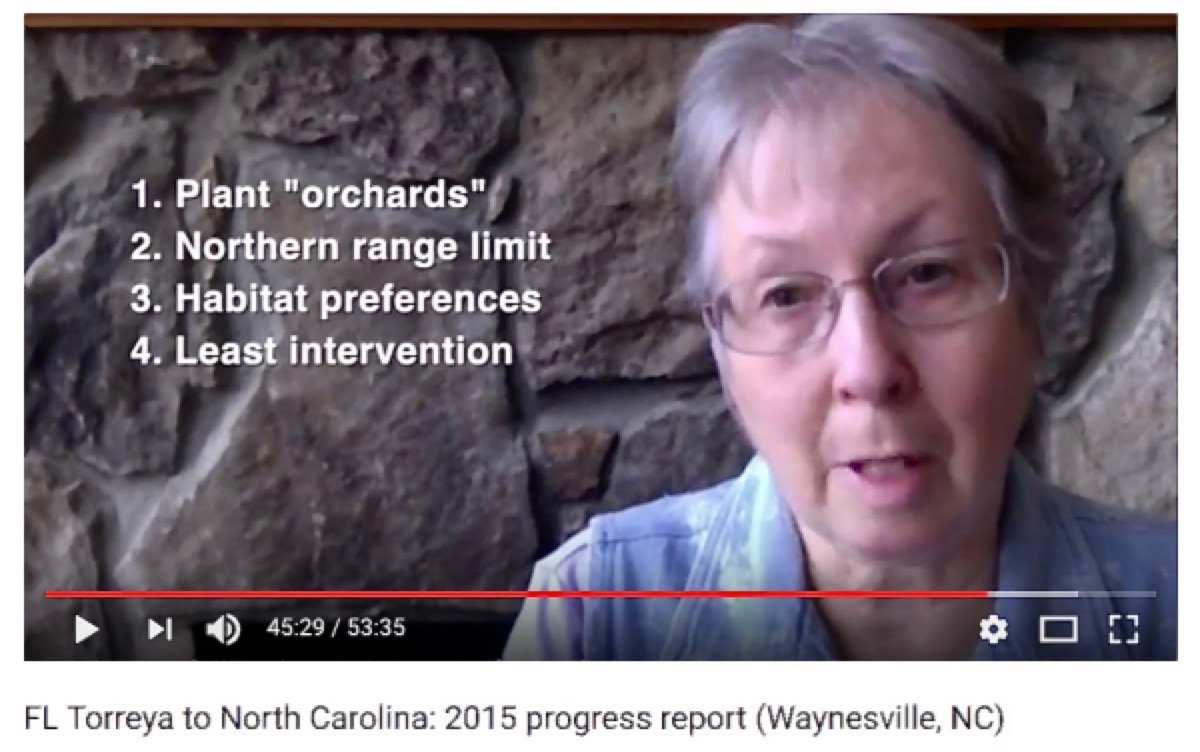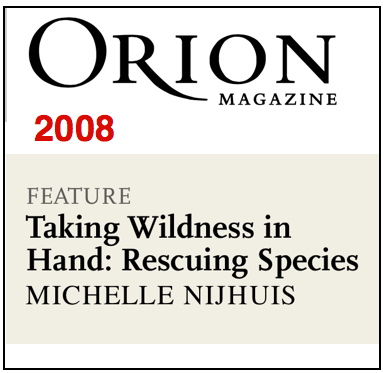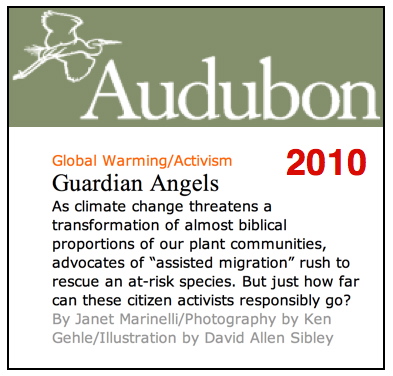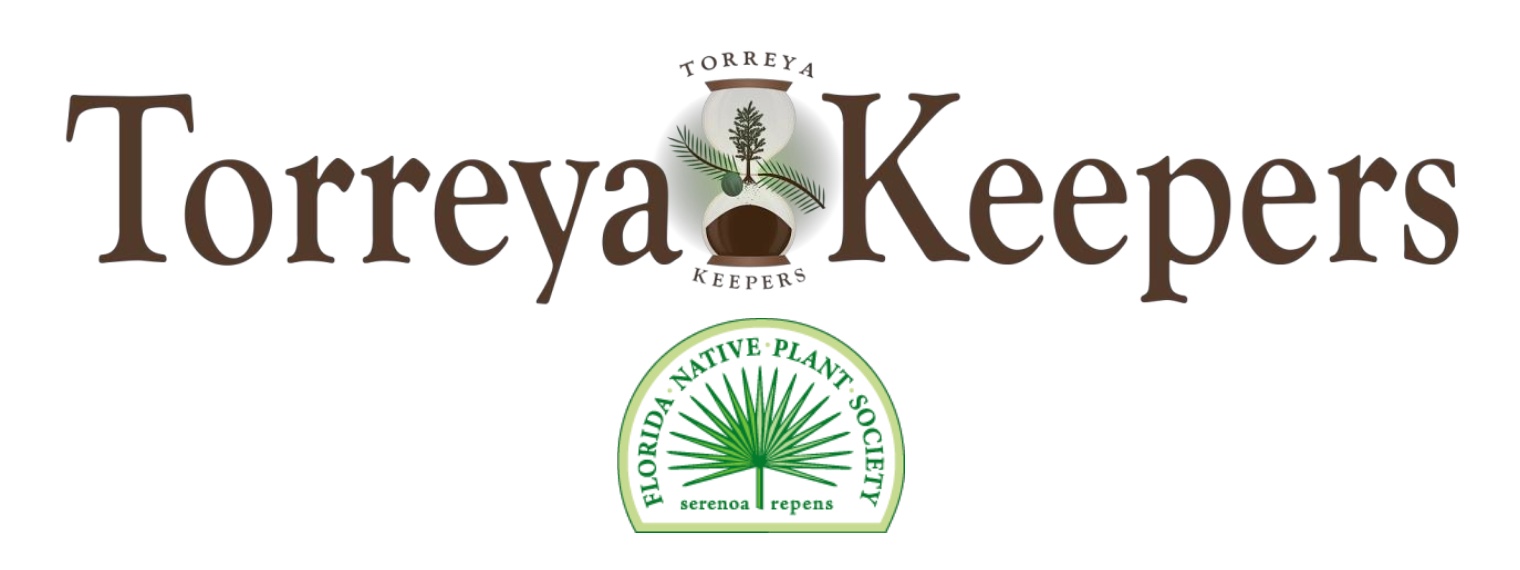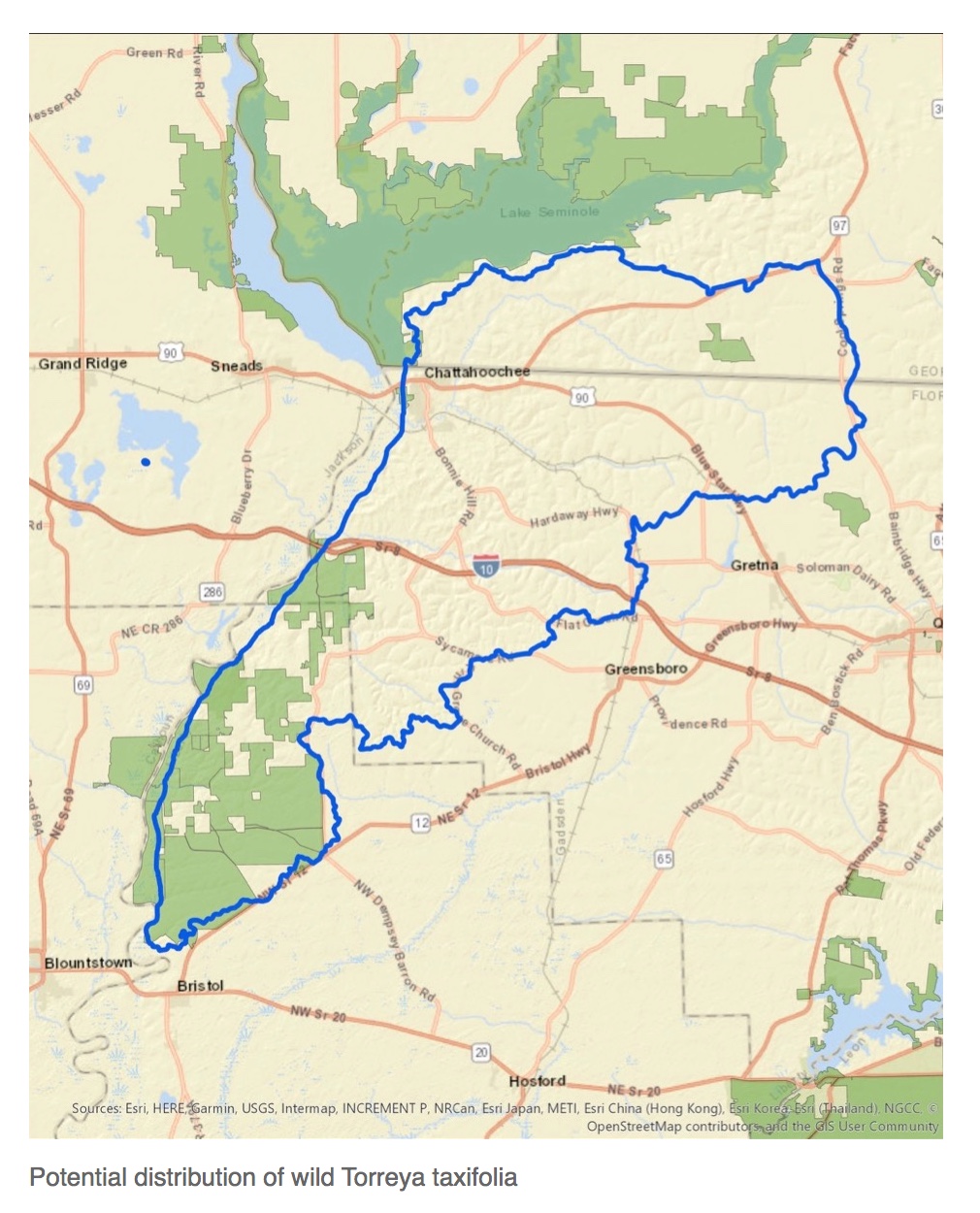Efforts to Save Torreya taxifolia by Connie Barlow, founder of Torreya Guardians
(updated August 2024)
OVERVIEW OF THE PROGRAMS: This website (Torreya Guardians) was initiated in 2005, 19 years after the U.S. Fish & Wildlife Service had established a recovery plan for Florida Torreya, which had been designated "endangered" in the USA in 1984. This page is intended to present (and link) all the official government publications, as well as online publications and news by or about the institutional and volunteer organizations working in their own ways on behalf of species recovery.
1. OFFICIAL PROGRAM - U.S. Fish & Wildlife Service (initiated in 1984) and U.S. Dept Agriculture (2020)2. CENTER FOR PLANT CONSERVATION - network of USA botanical gardens
3A. VARIOUS PUBLICATIONS by botanical gardens in Georgia, journal publications, and newspapers
3B. ARNOLD ARBORETUM (MA) & BOK TOWER GARDENS (FL)
4. INDEPENDENT CITIZEN PROGRAM - Torreya Guardians (initiated in 2005)
3. FLORIDA NATIVE PLANT SOCIETY SUBGROUP - Torreya Keepers (initiated 2018)
FLORIDA TORREYA AS CASE STUDY IN CLIMATE ADAPTATION: "Efforts to save" Florida Torreya began so early, and have met with such controversy, that this subcanopy "glacial relict" tree is now regarded as the classic case internationally for difficulties in moving forward with climate adaptation in conservation biology and restoration ecology. Access this precedent-setting aspect of Florida Torreya's conservation history:
• "Assisted Migration or Assisted Colonization: What's in a Name?"
IUCN "Conservation Actions" extract for this Critically Endangered species:
CONSERVATION ACTIONS: Torreya taxifolia has been the focus of extensive conservation interventions. The majority of its range lies within protected areas. Regular census' are carried out to monitor the state of the remaining trees. An ex-situ programme was initiated in the 1980s and clonal collections have since been established in several areas away from its native habitat. Some reintroduction work has been attempted within its natural range but this has not been successful to date. Various research programmes have been initiated to identify the causal agent of its decline: these are ongoing. T. taxifolia was listed as federally Endangered by U.S. Fish and Wildlife Service in 1984. A recovery plan was formulated in 1986 and has recently been reviewed and updated (U.S. Fish and Wildlife Service 2010).
ABOVE SOURCE: Royal Botanic Garden of Edinburgh, Torreya taxifolia.
• DEC 2023: Below are three screen captures of the VIEW IMPLEMENTATION STATUS table from the official USF&WS page for Torreya taxifolia. Note: To see all of the currently 40 entries, first look at the upper left part of the table and click "Show 50 entries." Then scroll to the right for the table topic titled "Comments." There you can scroll downward to see all the text entry details for each of the 40 items. 1. OFFICIAL PROGRAM: U.S. Fish & Wildlife Service
ACTION: "Establish cuttings" • A 2022 paper, "Data sharing for conservation: A standardized checklist of US native tree species and threat assessments to prioritize and coordinate action", put in context Florida torreya as one of just six trees listed as endangered or threatened.
ACTION: "Establish experimental collections outside native habitat"
ACTION: "Establish program to obtain cuttings"
• A 2020 U.S. Fish & Wildlife Service official document reports cumulative government spending for each species from 1988 through 2020. The image below is just a piece of Table 2, which entails (in order of expenditures from highest to lowest) the expenditure rank of 1,599 of the 1,821 domestic species (and subspecies) listed as endangered (E) or threatened (T) as of 2020. Florida torreya was the third highest-funded plant. A saltwater plant and an orchid native to springs in five western states were the only plants that received more funding; (plants entail the majority of listed species). Of the other 6 tree species (image above), Betula uber was among the lowest cumulatively funded of all species: just $100. However, because this tree was the first plant listed, its major recovery actions would have occurred before the 1988 amendments to the 1973 Endangered Species Act required species-specific annual reports of expenditures details.
The prime advantage of the official recovery program is that it is authorized to work directly with Torreya specimens growing naturally within the historically native range. Professional collaborations have been established with governmental institutions in Florida and Georgia, as well as with botanical gardens and universities in those and other states. The biggest constraint has been that the recovery plan (1986, updated in 2010 and again in 2020) has not been written or interpreted in ways that include experimentation with "assisted migration" into natural forested habitats northward of the northernmost region of Georgia. While "assisted migration" has from the outset been a controversial topic among professional conservation biologists, a formidable obstacle for U.S. national (and likely state) governmental agencies is that mention of past and ongoing anthropogenic climate change as a reason for undertaking assisted migration propels management decisions into a highly contested political arena.
BACKGROUND ON ENDANGERED SPECIES ACT
"EXCEPTION" FOR PLANTS from Wikipedia:
2022 UPDATE on the official program: Proposed federal regulationno longer restricts endangered species to recovery only in "historical range"
FWS Press release quote by Secretary of the Interior Deb Haaland: "Climate change and the rapid spread of invasive species pose an ever-increasing threat to native biodiversity. The time to act — and use every tool at our disposal — is now.... The growing extinction crisis highlights the importance of the Endangered Species Act and efforts to conserve species before declines become irreversible. This effort to update proven conservation tools will help ensure species on the cusp of extinction can recover and thrive for generations to come."
JUNE 2023 the new rule was adopted: Federal Register, Vol. 88, No. 126, p. 42642-42651
U.S. FISH & WILDLIFE SERVICE: ONLINE RESOURCES AND OFFICIAL ANNOUNCEMENTS
• Georgia Plant Conservation Alliance Policy Statement (2008)• U.S. Fish & Wildlife Service Florida Torreya webpage - updated ongoingly, with links to all below:U.S. DEPARTMENT OF AGRICULTURE PUBLICATIONS• USF&WS 1984 Proposal to Determine ... as endangered• USF&WS 1984 Determination of Florida Torreya as Endangered
• USF&WS 1986 original recovery plan
• USF&WS Recovery Plan (2010 revised)
• USF&WS Policy correspondence reply to Barlow (23 October 2019)
Barlow August 2019: "Report to Secretary of the Department of Interior and Director of Fish & Wildlife Service: Volunteer Actions of Torreya Guardians Support New Endangered Species Administrative Policies"• USF&WS Recovery Plan (2020 revised)• USF&WS Decision on Petition, 29 Sept 2021. Highlighted copy, via this website: PDF
Petition to Downlist from endangered to threatened by Connie Barlow (9 September 2019)• USF&WS Data Table: Record of Actions ("comments" column supplies the most detailed project reports)
• USDA, U.S. Forest Service, Southern Research Station Science Communications - "Saving the Torreya: Workshop Brings Scientists and Conservation Leaders Together", by Sarah Farmer, 8 May 2018.2. CENTER FOR PLANT CONSERVATION (network of botanical gardens in USA)• USDA, U.S. Forest Service, Southern Research Station Science Communications - "Detecting the Pathogen That Stalks the Endangered Florida Torreya", by Kim Crider, 28 October 2020.
EXCERPT: "... USDA Forest Service scientist Tyler Dreaden and colleagues from the University of Florida are developing a genetic test to identify the torreya fungus. This work can ensure the health of the collections and reduce unknown risks to other species. The researchers drew on published DNA sequences for F. torreyae canker pathogen and genetically related species. They mined these genetic codes to find the parts unique to the torreya pathogen. The technique successfully distinguished the torreya fungus from other related fungal species. The next step — and ultimate goal — is to develop the method further so it can quickly detect the torreya fungus directly from Florida torreya tissue samples. This study brings hope to expanding conservation efforts that preserve the genetic variation of Florida torreya in anticipation that it can thrive once again.... Read the article in the journal Forest Pathology. For more information, email Tyler Dreaden at [email protected]. "Detection method for Fusarium torreyae the canker pathogen of the critically endangered Florida torreya, Torreya taxifolia".
• Center for Plant Conservation (CPC) Torreya taxifolia page - list of current research and actions by affiliated botanical gardens. As of 2021, the affiliates are Atlanta Botanical Garden, Bok Tower Gardens, Dawes Arboretum, and Polly Hill Arboretum. Another webpage on the CPC site has a 10-min video by Dr. Emily Coffey of ABG in May 2018. Coffey's illustrated talk includes details on seed production (13,000 seeds were produced at the Blairsville n. Georgia site autumn of 2017). Because this documentation is detailed and important, the webmaster of Torreya Guardians posted screen-captured illustrations and excerpts of the transcript and posted them as a new page on this website in 2021: "What's New for Torreya taxifolia, North America's Rarest Conifer?".3. VARIOUS PUBLICATIONS BY ATLANTA BOTANICAL GARDEN, STATE BOTANICAL GARDEN OF GEORGIA, ETC.• VIMEO: "In situ recovery efforts of Torreya taxifolia following Hurricane Michael", 7-minute powerpoint program by Dr. Emily Coffey of Atlanta Botanical Garden.
• "Cones and Clones To Save Florida Torreya", based on information from Emily Coffey, Ph.D., Vice President of Conservation and Research, Atlanta Botanical Garden and posted on the website of the Center for Plant Conservation.
If anything, the hurricane reinforced the need for a focused effort on ex situ conservation. Two weeks after the storm, Dr. Coffey conducted a high-level assessment and was astonished by the damage. Heartbroken, she stood at the top of a ravine and found 80-90% of the mature trees gone. But there was also a glimmer of hope. With the crowns of trees strewn everywhere, she scrambled down a steep ravine in search of one of the largest trees documented in the park – and found it alive. This tall, beautiful female torreya had produced one of the first recorded seedlings in more than 20 years. And the seedling was also still standing! A huge grapevine had prevented a large sycamore from falling directly on the female torreya. It was a very precarious situation, requiring hours of careful planning and saw work to prevent the sycamore from crushing the torreya. “In the end, we were able to save the tree and leave renewed and filled with hope that we would be able to save more trees, and that not all of the individuals had been lost,” Dr. Coffey recalls. "It gave us great resolve and hope, which is what we continue to thrive on." ... Some Florida torreya supporters are keen to help the species by relocating the trees or seedlings into the Appalachian Mountains. The garden is working hard to avoid the spread of the fusarium into the Appalachian wilderness.• CPC page for Atlanta Botanical Garden (lists contact emails)• CPC page for State Botanical Garden of Georgia (lists contact emails)
• CPC video short: "Ex situ Conservation and Ontogenesis of Torreya taxifolia Embryos", May 2021, presenting the work of: Neusa Steiner, Federal University of Santa Catarina, Emily Coffey, Atlanta Botanical Garden, Jason Ligon, Atlanta Botanical Garden, Lisa Hill, USDA-ARS, Emma Dorr, USDA-ARS, Laurie Blackmore, Atlanta Botanical Garden, Christina Walters, USDA-ARS.
• 2024 Conference video: Florida torreya segment: timecode 22:25 - 23:18 on regrowing torreya after somatic embryogenesis (by ABG staff).
• NatureServe Explorer: "... Unfortunately, little can be done to protect Torreya trees in the wild (Martin 1987, pers. comm.). Application of fungicides has been recommended by Alfieri et al. (1967) and Stalter and Dial (1984), but the Florida Torreya Recovery Plan (USFWS 1986) noted that applications of Maneb, Benomyl, Daconil (Chlorthanlonil) and Zyban to Torreya trees in Maclay Gardens over the past 25 years have not succeeded in controlling the blight (USFWS 1986). Fungicide use at Torreya State Park has also been unsuccessful (Martin 1987, pers. comm.). In addition, these chemicals might harm beneficial mycorrhizal fungi that may be associated with Torreya roots (USFWS 1986)..."• "The Ex Situ Conservation of Stinking Cedar", July 1998, collaboration of Botanic Garden of Smith College and Atlanta Botanical Garden, published in Public Garden 13(3). Four authors: Bibiana Garcia Bailo, Ron Determann, Rob Nicholson, Stephen SojkowskiEXCERPTS: ... The cultivation of Torreya taxifolia began not long after its discovery in 1835 by Hardy Bryant Croom. By 1859, A.J. Downing reported on the success of the plant growing in cultivation: "Our best specimen is about eight feet high, very dense, showing nothing but foliage, like a thrifty arbor vitae, and remarkable, particularly in winter, for the star-like appearance of the extreme tips of its young shoots. We have returns of this tree from Elizabethtown, N.J., Dobbs' Ferry, Yorkville, Flushing and Newport, in all of which places it succeeds well, and is considered hardy, except at the last place where it is reported tender." Sargent in 1905 wrote that Torreya was "now often planted in the public grounds and gardens of Tallahassee, Florida."• Georgia Department of Natural Resources: Biodiversity Portal page on Torreya taxifolia. Note: When Connie Barlow accessed this page in 2022, "assisted migration" was presented as a "threat" to this species: "Logging, conversion of habitat to pine plantations, fungal blight, extreme hurricane events, diversion of resources to uninformed and unauthorized assisted migration efforts." In the section titled "Conservation Management Recommendations" this appears: "Discourage attempts at assisted migration unless carried out by authorized agencies." (Excellent photos appear on that page.)
At present, no trees of any size are known in the northeastern United States and the successful long-term cultivation of Torreya taxifolia north of Virginia remains unknown. The number of mature trees in cultivation outside of Florida may number less than two dozen. In contrast, old and large trees of Torreya nucifera are found in Boston, Massachusetts, and Swarthmore, Pennsylvania.
Beginning in the late 1950s a sharp decline in the health and reproductive capacity of the native stands was noticed. Since then, all full-sized mature individuals have perished and seed production is extremely rare in the wild (E.O. Wilson, pers. comm.). Where trees of 60 feet were found, few individuals over 10 feet are now known. Research into the cause of the decline is ongoing, but in situ preservation appears problematic and management efforts now include the propagation of rooted cuttings from documented wild stands to be grown in ex situ populations. Because set seed is so rare in the wild, vegetative propagation is the only means left to secure documented wild germplasm for study, possible distribution, and possible reintroduction.
... Cuttings were potted and grown for two years and then shipped to botanic gardens and biological institutions worldwide for observation and research. Institutions receiving plants were the Arnold Arboretum of Harvard University; Bok Tower Gardens; Royal Botanic Garden, Edinburgh; Illinois Natural History Survey; Mercer Arboretum; North Carolina Botanic Garden; Tall Timbers Research Station; USDA Forest Service, Berkeley; and USDA Forest Service, Gulfport.
Of particular note is the collaboration between The Botanic Garden of Smith College and the Atlanta Botanical Garden. Cuttings sent to the Atlanta Botanical Garden were raised in containers and by 1997 some had grown to five feet and had begun to set seed. A nursery mix of 15 parts composted pine bark mulch, one part granitic sand, and amendments of lime, bone meal, and cow manure proved to be an excellent growing medium, and the plants were grown outside under 50 percent shade.• State Botanical Garden of Georgia "Priority Species Recovery Projects"
• 2025 1-minute video of declining female torreya at State Botanical Garden of Georgia.• Endangered Species: Florida Torreya", by Dr. Kim D. Coder
• Rarest Native Trees of Georgia, by Dr. Kim D. Coder
• "The Fall of the Torreya and What Is Being Done To Save It" - 2019 audio interview of Jennifer Ceska, State Botanical Garden of Georgia • "Investigating Silica Depositional Capacity in the Critically Endangered Florida Torreya (torreya Taxifolia) and Its Relevance for Plant Health" - new research project collaboratively launched by Florida State University and Atlanta Botanical Garden, with grad student Niall Whalen, 2025. • Atlanta Botanical Garden Torreya page on Ecological Restoration Alliance of Botanic Gardens website (latest update 31 Jan 2019) • "Conservation Outlook For Florida’s Threatened, Endangered, and At-risk Species" (p. 29 is Florida Torreya), USF&WS Magazine, September 2015.• Update on the Recovery of T. taxifolia at the Atlanta Botanical Garden (2003)
• The Florida Torreya and the Atlanta Botanical Garden, by David Ruland, in Conifer Quarterly, pp. 10-14 (2007)• GEORGIA PLANT CONSERVATION ALLIANCE: A Partnership to Conserve Endangered Flora, by James Affolter and Jennifer Ceska, undated.
• "ABG's Conservation Nursery", 2015, [genetic safeguarding and propagation at ABG's 2-acre nursery in Gainesville GA]
• Atlanta Botanical Garden looking to plant 1,600 endangered tree seedlings (2017)
• Atlanta Botanical Garden April 2019 "President's Message" on Torreya taxifolia
• Atlanta Botanical Garden opens Southeastern Center for Conservation this summer, Atlanta Journal-Constitution (2019)• "After the Storms", 2020 article by Lila Uzzell, on ABG role in monitoring effects of Hurricane Michael on 40 wild torreyas selected for study in Torreya State Park, published in Atlanta Botanical Garden's magazine, PlantIntel.
• 1998 collaborative report: Smith Garden and Atlanta Botanical Garden. Title: "The Ex Situ Conservation of Stinking Cedar" by Bailo, Determann, Nicholson, and Sojkowski, published in Public Garden, July 1998, 13(3). • "Genetic variation in the endangered Florida torreya (Torreya taxifolia Arn.) and implications for conservation", August 2024, by Tyler J. Dreaden et al. (3 authors are USDA staff, 2 are Atlanta Botanical Garden, and 1 is an author of the Fusarium torreyae discovery), Journal of the Torrey Botanical Society.• Florida torreya entry (p. 440) in Field Guide to the Rare Plants of Georgia (by Linda Chafin, 2007)
• PHOTO on Flickr of seed production at Smithgall Woods (Sept 2008)
• Record of Branchlet Rooting at Smith College (1993) - url doesn't work in 2021
• Torreya Symposium (March 2018)
• VIDEO: ABG Emily Coffey short powerpoint program on onsite documentation and rescue of torreya survivors post Hurricane Michael (2019)
• SOUTHERN HIGHLANDS RESERVE (Lake Toxaway, NC) - "Stewards of an Endangered Tree: Torreya taxifolia Safeguarding Project" (3 February 2021); "164 Million Old Addition" (3 February 2022).
• TECHNICAL PAPER (with 2 ABG staff as coauthors): "Somatic embryogenesis, plant regeneration, and cryopreservation for Torreya taxifolia, a highly endangered coniferous species", by X. Ma, K. Bucalo, R. O. Determann, J.M. Cruse-Sanders, and G.S. Pullman, 2 May 2012, In Vitro Cell.Dev.Biol.-Plant.
NOTE ON OFFICIAL EX SITU PLANTINGS - Initially, ex situ plantings focused on same-latitude sites, notably:
• Maclay Gardens / State Park/ Tallahassee, FL - The 1986 Recovery Plan notes trees at this location. It appears these trees had the blight or contracted it shortly after planting. Trees are still growing onsite. Original trees were planted at this site in the 1930s and they were being treated for disease since 1955.In the 21st century, official outplantings have shifted to northern Georgia: Smithgall Woods, Vogel State Park, and a location in Blairsville. More detail on the Smithgall Woods State Park Torreya Seed Orchard in northern Georgia can be found in the "Comments" column of this USF&WS matrix of recovery actions: Record of Actions. See excerpts below:• Harrison Experimental Forest / US Forest Service / Saucier, MS - Three trees from a population there were used in a photosynthetic experiment. Torreya Guardian Paul Camire queried by email in 2018 and learned that several specimens have died and the 15 remaining trees (sickly, 5ft and under in size) are struggling and infected with the blight. Editor's note: This location is only about 20 miles inland of the Gulf Coast, so rampant disease is not unexpected.
Georgia: The ABG and the Georgia Department of Natural Resources outplanted 19 individuals of T. taxifolia at the Smithgall Woods in White County in north Georgia. The purpose of the Smithgall Woods collection and two additional off-site plantings (Blairesville, GA and Vogel State Park) were to establish safeguarding populations of Torreya to conserve material that had been propagated at the ABG in backup collections at more than one location. The material planted at Smithgall Woods was propagated from all Georgia source population material (Army Corps. Of Engineers, site at Woodruff Dam, Lake Seminole, in Georgia). The trees have grown quite large and are now reproductively mature producing male and female cones annually. Most of the plants were placed in full sun and they are quite healthy. The trees at Vogel State park are smaller than those at Smithgall Woods and have not yet reached reproductive maturity.The 2010 Recovery Plan Update (p. 9) documented seed production at Smithgall Woods:The Atlanta Botanical Garden (ABG) and the Georgia Department of Natural Resources outplanted 19 individuals of T. taxifolia at the Smithgall Woods in White County in north Georgia. The purpose of the Smithgall Woods collection and two additional offsite plantings (Blairesville, GA and Vogel State Park) were to establish safeguarding populations of Torreya to conserve material that had been propagated at the ABG in backup collections at more than one location (CruseSanders 2010, pers. comm.). The material planted at Smithgall Woods was propagated from all Georgia source population material (Army Corps. of Engineers, site at Woodruff Dam, Lake Seminole, in Georgia). The trees have grown quite large and are now reproductively mature producing male and female cones annually. Most of the plants were placed in full sun and they are quite healthy. Major threats to the trees at this location are lawn management (weed wackers) and fire ants. The trees at Vogel State park are smaller than those at Smithgall Woods and have not yet reached reproductive maturity (Cruse-Sanders 2010, pers. comm.).BGCI and IABG's Species Recovery Manual, published online May 2018, 100 pages.Editor's note - Seed production on the Atlanta campus of the Atlanta Botanical Garden began before 2007, as this 2007 article by ABG staff stated, "... Many of the original Arnold Arboretum cuttings have matured into cone and seed producing trees [at Atlanta Botanical Garden] that, in total, form over 500 viable seeds per year on average. These plants are grown in the ABG "seed orchard" and propagules produced from these seeds have been used to facilitate the next phase in the recovery of this species." Torreya Guardian founder Connie Barlow posted photographs of the AGB seed production and germination operation during her second site visit to AGB December 2007.
EXCERPT: "Case Study 7 Preparing for recovery: The Florida Torreya" ... ABG and the University of Georgia have also established a T. taxifolia seed orchard, where nearly 5,000 cones were harvested in 2016. Seed and seedlings are being distributed to other botanic gardens to establish additional ex situ collections and another seed orchard. The next step for the conservation program is to reintroduce the species into areas where it has been lost and to continue protecting trees from deer pressure."Atlanta Botanical Garden January 2019 update, published online, "Recovery of the Florida Torreya - one of the rarest conifers in the world," Ecological Restoration Alliance of Botanic Gardens (one page)EXCERPT: ... In 1990, Atlanta Botanical Garden received 155 clones of T. taxifolia propagated from the remaining natural population by Arnold Arboretum and the Center for Plant Conservation. This material has been safeguarded at the Atlanta Botanical Garden since that time, and propagation efforts have increased the collection to include almost 1,000 plants, including nearly 500 distinct vegetative clones from the wild. One of the limiting factors to ex situ conservation of this species is the inability to use conventional seed storage techniques for preserving germplasm. Torreya taxifolia produces recalcitrant wet seeds that cannot be dried for storage in freezers. Therefore, until recently the only way to maintain ex situ germplasm was through living collections. In collaboration with Georgia Institute of Technology, a somatic embryogenesis tissue culture system was developed to initiate cultures, produce somatic seedlings and cryogenically store cultures of T. taxifolia. PHOTO CAPTION: Torreya taxifiolia seed orchard (a collaborative project between ABG & UGA) - This female tree was grown from lateral cuttings and, along with 20 others, was planted in 2000. Nearly 5,000 fruit were harvested in 2016."Stewards of an Endangered Prehistoric Tree: Torreya taxifolia Safeguarding Project", 3 February 2021 (news), Southern Highlands Reserve [Lake Toxaway, North Carolina].EXCERPT: It is our responsibility to the land and our ecosystem to do everything we possibly can to help endangered plants and animals find a safe haven here at the Reserve. One project we have been working on since April of 2018 is safeguarding Torreya taxifolia seedlings. Working with the Atlanta Botanical Garden, we signed a Memorandum of Understanding (MOU) memorializing our commitment to protect this endangered species to the best of our ability. In 2018 we set up five 3'x3' square raised beds and filled them with different substrates. The boxes have a mesh bottom to prevent burrowing animals digging from underneath and a high arching fence to deter squirrels from eating the seeds before they germinated. Torreya taxifolia was one of the first species to be federally listed as an endangered plant in 1984, in large part due to fungal and needle blights and logging. This tree has been around for 160 million years! It is estimated that there are about 500-600 trees left in the wild — only 0.3% of their original population — making them one of the rarest conifers in the world. Scale and root rot are other factors in their decline. Planting seeds we acquired from Atlanta Botanical Garden in various substrates allowed us to determine how these soils affect the growth of the tree. Although the common name for this species is Florida nutmeg or stinking cedar, North Carolina has claim to the largest living T. taxifolia at 45 ft tall and 35" wide.... This year we measured the Torreya taxifolia seedlings in all the raised beds and found that the plot with the biochar is the tallest, averaging 7", with one reaching a full 12"! In second place is the plot with the well-aged pine bark fines at 6.8". Third is the plot with fresh pine bark fines at 6.5". Fourth place goes to the plot with the DieHard at 6.2". Lastly, the second plot with fresh pine bark fines only germinated eight out of 100 seedlings with an average height of 5". These results do support the effects of biochar on Florida nutmeg seedlings (see Tables below). The germination rate of biochar plot also performed best by far, with 80 out of 100 seedlings sprouting. Interestingly, between 2019 and 2020, five extra seedlings per plot germinated — we'll take it!... We plan to pot up all seedlings in April while they are still dormant and send our results to the Atlanta Botanical Garden. Increasing the population of this endangered species by 271 new trees is important and allows us to continue our mission of research to help sustain biodiversity.Atlanta Botanical Garden June 2019 Update, published online, "Atlanta Botanical Garden opens Southeastern Center for Conservation this summer".EXCERPTS PERTAINING TO FLORIDA TORREYA: ... This summer the garden opens its Southeastern Center for Conservation, a $7 million two-story building adjacent to the Fuqua Orchid Center. It was funded through the successful $53 million Nourish and Flourish fundraising campaign, which included $40 million for capital improvements and $13 million for the endowment. The new center will serve as a home for the garden's conservation, education, and experimentation. The building includes a 3,800-square-foot research facility with a molecular lab that lets scientists examine genetic material at the nucleotide level. The cold-storage seed bank is augmented by cryogenic coolers that can preserve the embryos of the Torreya trees as they try to determine why the trees die in the wild before they can become adults."On my watch — Learning about the Stinking Cedar tree from Tree Warden Greg Kramer", published 10 Sept 2022 in Greenwich Sentinel of Greenwich, Connecticut.... They also feel the pain when a natural disaster spoils plans. The garden had transplanted 700 Torreya trees to Torreya State Park in Florida, with noted Harvard biologist E.O. Wilson, 88, as a guest of honor. Then, Hurricane Michael destroyed the entire stand, dumping hardwoods on top of little saplings. "It can be really discouraging," said Carter. But even if they're not successful now, they retain hope for future prospects, she said. "One thing we're doing is keeping individual genetic material alive," said Carter. "In the future, we hope there is something to be learned from holding on to these plants."
SUMMARY: Local newspaper reports on a May 2021 planting of three small potted seedlings of Torreya taxifolia, at Montgomery Pinetum of Greenwich Connecticut, which was facilitated by Atlanta Botanical Garden. The tree warden, Greg Kamer, is quoted in the article."Giant Genome: Evaluating the conservation genetics of Florida torreya", by Lauren Eserman, 2022, issue 4 of Atlanta Botanical Garden Synecology, pp. 8-9.EXCERPTS: ... That Greg was able to secure three Stinking Cedar Tree seeds first from the Atlanta Botanic Garden overseeing conservation efforts for this species, that were then propagated at Florida’s Bok Tower Gardens where Greg has worked was rare in itself. And he was happy to show me how they are thriving.... They are fenced in from the deer and are a lovely green color. Planted as of May of 2021, they arrived a foot high and have now more than doubled their height, look swell, and smell nicely. "This year was very dry and sunny, and they did well," shares Greg. "They're quite hardy. Even though they're native to Florida, they prefer cooler weather." Fortunately, too, that deadly stem disease or fungus doesn't survive further north, he tells. "So, the tree itself is not in risk of extinction. It just needs to be planted out of its native range. It's a pretty resilient tree. When it was a common component of the forest in the Apalachicola region of Florida, it was a quite common understory tree."... Greg explains the three trees here were specifically determined by the Atlanta Botanic Garden as the "best fit for our collection. And when they do reach a reproductive stage, we're not allowed to share the seeds with anybody. We have to get permission from Atlanta in order to do so. And they would then probably collect the seeds themselves and then distribute them to whoever requested."
EXCERPTS: Florida torreya (Torreya taxifolia) is one of the rarest conifers in North America. In the last century, populations have declined from nearly 700,000 trees to around 700 trees today. The species is listed as 'critically endangered' by the International Union for Conservation of Nature (IUCN) and 'endangered' by the United States government. One of the major causes for the decline of T. taxifolia is an invasive fungal pathogen, Fusarium torreyae. In 2018, Hurricane Michael also killed many wild T. taxifolia trees."Forty Trees: Insights from the hurricane survivors of an endangered conifer", by Loy Xingwen, 2022, issue 4 of Atlanta Botanical Garden Synecology, pp. 10-11.
The Atlanta Botanical Garden has been a leader in the conservation of T. taxifolia since 1991. To safeguard the future of this species, the Garden's Southeastern Center for Conservation has collected and cultivated branch cuttings from over 400 wild trees, representing more than half of the total known wild population. These newly propagated trees have been added to the Garden's Conservation Safeguarding Nursery. This proved to be a vital conservation measure, as many of the wild trees from which cuttings were originally taken have since perished. Without safeguarding collections, unique genetic diversity may be lost forever whenever a wild tree dies.
The Center recently conducted a study to examine the genetic diversity contained within T. taxifolia. One objective was to evaluate whether current collections sufficiently capture the genetic diversity of the wild population. This is vital for ensuring that current and future safeguarding practices are effective. Understanding the genetic makeup of T. taxifolia may also help in future breeding programs for better fungal resistance. A second objective was to assess overall levels of genetic diversity in the remaining wild population.... A technique called 'target gene capture' was used to target sequencing on specific loci within the large and repetitive genome of the species. To this end, the Center collaborated with the University of Georgia to develop a target capture bait set that can be used on T. taxifolia. Study results show that genetic diversity of the species is compa- rable to other conifers with narrow ranges, and the wild population has maintained unexpectedly high genetic diversity despite having suffered tremendous decline.... Overall, the high level of genetic diversity within the species is promising for breeding programs.EXCERPTS: On October 10th 2018, Hurricane Michael became the first recorded Category 5 hurricane to make landfall in the Florida Panhandle. In addition to devastating regional towns and cities, the Hurricane blasted through Torreya State Park — the last stronghold of one of the world's most threatened conifer trees: Florida torreya (Torreya taxifolia). The storm instantly killed many T. taxifolia and destroyed vast areas of their forest habitat. EDITOR'S NOTE: This entire short article is so helpful for understanding the natural history of this species in place that I am excerpting not here but in the "Subcanopy tree" section of the lengthy "Natural History" webpage."A Conifer's Community: Exploring the habitat of Florida torreya at Torreya State Park", by Loy Xingwen, 2022, issue 4 of Atlanta Botanical Garden Synecology, pp. 12-13.EXCERPTS: ... SLOPE FORESTS grow in the cool and moist microclimates created by steep-head ravines — the habitat of Florida torreya. Slope forests boast immense plant diversity. Other rare species found here include Ashe's magnolia, Florida yew, croomia and bay starvine.... Once abundant in its habitat, the species has declined dramatically in the last century. Potential causes include fungal diseases and climate change. DECIDUOUS TREES create the dense canopies of slope forests, which support shade-loving plants. Typical canopy trees here include American beech, tulip poplar, white ash and black oak.... PLANTS OF COOLER CLIMATES thrive in the shade and shelter of steephead ravines. Species typically found in the Piedmont or southern Appalachian mountains are common here: mountain laurel, eastern leatherwood, wild hydrangea, rattlesnake plantain and bloodroot. This unique and rare community of cool and warm flora is threatened by climate change.UF/IFAS Extension Leon County, article by guest columnist Stan Rosenthal (U Florida Forestry Agent Emeritus) published in Tallahassee Democrat, 11 November 2022, titled "Here's how to create a vegetative privacy fence that blooms, feeds wildlife."EXCERPT: "... For variety you may wish to add a few eastern red cedar, Florida torreya, Florida yew, southern magnolia, American holly, cherry laurel, and for wet areas, Florida anise. The cherry laurel will do a great job but will spread quite readily. All the aforementioned plants are evergreen."Editor's note: The article links to a U Florida website that entails distinct pages on a vast variety of trees and shrubs (from all over the world) and appears to have been created in 1994. It is "Tree selection for urban and suburban landscapes". Links from there eventually lead to a linked list of Fact Sheets for 680 Tree Species, which offer practical guidance for soil types, sunlight, etc. for tree species from all over the globe. Thus, in addition to the Fact Sheet for Florida Torreya, one also can access a fact sheet for the Japanese species, Torreya nucifera.
Editor's Note: Two law review articles posit that the existing Endangered Species Act and regulations would allow officials to move ahead with "assisted migration" with no need for modification. They are:
• "Biodiversity on the Brink: The Role of 'Assisted Migration' in Managing Endangered Species Threatened with Rising Seas", by Jaclyn Lopez, Harvard Environmental Law Review, 2015.• "Endangered Species Act to the Rescue? Climate Change Mitigation and Adaptation Under the ESA", by Olivia Bensinger, NYU Environmental Law Journal 2017.
3B. ARNOLD ARBORETUM (MA) & BOK TOWER GARDENS (FL) • Chasing Ghosts: The steep ravines along Florida's Apalachicola River hide the last survivors of a dying species, Torreya taxifolia, by Rob Nicholson, 1990, Natural History Magazine
EXCERPTS: ... All the unknowns confound any recovery plan. Is Torreya an early victim of global warming and a precursor of a new wave of inexplicable extinctions? Has local land use destroyed this Torreya habitat? Is there any point in trying to fortify existing populations by replanting if a virulent pathogen lurks unchecked? Will propagations of cuttings from existing wild trees carry a new pathogen wherever the new trees are distributed? Or, frozen by doubt, will plant scientists do nothing while the unique species slips away, tree by tree?• List of torreya specimens sampled 1985-89 by Rob Nicholson for Arnold Arboretum (excel doc) • "Finding a Home for Torreya taxifolia", July 2012, p. 12 of "A Quarter-Century Perspective on the Center for Plant Conservation Collections at the Arnold Arboretum," by Abby Hird, in Arnoldia, on transfer in 2010 of potted original cuttings from Harvard's Arnold Arboretum to Atlanta Botanical Garden.
... The Apalachicola Bluffs and the ravines that dissect them are at the cusp of the deciduous woodlands and the lush subtropical jungle. It is an undecided forest, its luxuriant ecotone having been shaped by the forces of glaciation during the Pleistocene era. As a New Englander used to deciduous woods, I was unsettled by seeing beech, maple, and hickory mixed with bold fan-leafed palmettos, spiky yuccas, and huge evergreen magnolias.
... In June 1989 I joined Mark Schwartz and we surveyed as many ravine systems as possible, carefully mapping and labeling the plants growing there.... When we returned in the fall, we collected small cuttings, tissue samples, and soil samples for genetic, propagation, and pathological studies. Alarmingly, in just a few months, a number of our mapped trees had been lost — to deer rubbing, disease, and even falling limbs from the upper canopy. The species was going extinct before our eyes and will probably not last another generation.
... To travel the bluff tops down the steep slopes to the creek beds, 100 to 200 feet below, is to read a primer in zonal plant ecology. Species are stratified by drought tolerance and light demands. Those on the tops of the bluffs are adapted to full sun and dray conditions. Endangered gopher tortoiss burrow amid opuntia cactus, longleaf pine, yuccas, and bushes of sparkleberry. At the base of the ravines can be found the rare Florida azalea, native bamboo, and Sabal palmetto amid a thick tangle of Florida star anise that rivals the tangled rhododendron 'hells' of Virginia and Tennessee.
The steep pitch between these two zones includes a number of endemic plants: croomia, Ashe's magnolia, florida yew, pyramid magnolia, and Torreya, as well as species known throughout the eastern seaboard, such as American holly, American beech, tulip tree, and leatherleaf. The southern magnolia, known to me as an ornamental tree of glossy green, rubbertree-like leaves, festooned with outlandishly large white flowers, here grew as 100-foot forest giants, with a a first branch higher than a man could throw a rope and with crowns so dense they blotted out the sun.
The Florida yew, like the Torreya, belongs to the Taxaceae family. It is also a rare endemic, whose range is actually smaller than, and within, that of Torreya. Although occupying much the same habitat, the yew has not been affected by whatever is affecting its larger relative. The ravines are not identical, however. Variations in grade, soils, aspect, and moisture create subtly different habitats, some of which Torreya can tolerate. It dominates nowhere, and past references indicate it never did. It is an occasional midcanopy, midslope tree found on sandy limestone sols. In general Torreya prefers good drainage to flat, constantly wet soil; and while it is almost always found in filtered, dense shade, I have seen cultvated Torreya grow perfectly well in full sun. In its native environment, the stinking cedar may be better able to compete on the shaded slopes than in sunnier areas.
... More than 2,500 cuttings were collected from 166 trees and were treated with a variety of hormones to promote rooting. These were brought to Harvard's Arnold Arboretum, where 2,100 were successfully rooted and potted. The accession number of the sampled trees follows each of these clones (and any subsequent propagations) with the particulars as to the plant's original location in the wild. Therefore, in the distant future, ravines might be replanted with the same genetic material that once grew there. Cuttings taken from the wild five years ago are growing well and so far show no signs of disease.
... While the few remaining saplings may outlast the blight, not many people who have seen the trees would wager their homes on it. More likely, clusters of trees, propagated from specific ravines, will be grown in botanical gardens, universities, preserves, and state parks. This Florida native, as evidenced by the few healthy trees in cultivation, seems to thrive on the southern slopes of the Appalachian Mountains and is more cold tolerant than its present range would suggest. Possibly an Apalchicola refugium can be re-created, an artificial Torreya forest where pollen can float, genes mingle, and the evolution of the past hundred million years can continue, even if it is in a pitifully discounted format.EXCERPT: "... A large-scale ex situ effort began in 1985, funded by the CPC and the Arnold Arboretum (Nicholson 1996). Rob Nicholson and Mark Schwartz collected cuttings from 163 wild lineages of T. taxifolia and then distributed resulting plants to 10 institutions in North America and Europe in the early 1990s. Using a 1996 Arboretum inventory of 156 of the original lineages as a foundation, we conducted an international inventory of this species in 2009 and tracked down all possible specimens that originated from the original CPC material. Fortunately most of the lineages had been preserved among the institutions surveyed (a bene t of backing up collections). But about 20% were represented by only one or a few remaining plants per lineage, and about 40% of lineages existed only at one or two institutions. Lessons learned from this long-term ex situ effort include ensuring a collection holder has appropriate horticultural know-how, climatic compatibility, and staff commitment for successfully maintaining a collection. For example, a loss of 70% of unique lineages at the Arnold Arboretum was observed from 1989 to 2009. This loss is attributed to incompatible climate, poor adaptability to container nursery conditions, and human error (staff changeover, labeling errors, etc.). Further, 5 of the 8 institutions still maintaining the original T. taxifolia germplasm required accession data cleanup and several specimen identifications were determined lost or unknown due to accidental dissociation with accession numbers, labels, or records.... As a result of the 2009 ex situ inventory for T. taxifolia, redistribution of germplasm has occurred among collection holders to preserve and back up ex situ maternal lines at multiple institutions. Further, this inventory led to a successful transfer of this important CPC collection from the Arnold Arboretum to the Atlanta Botanical Garden in 2010."• A USF&WS publication stated this history of ex situ plantings at Bok Tower Gardens as a component of its "ACTION 332: Establish cuttings" within its "Recovery Plan Ad Hoc Report" results table, which is most easily viewed as excerpted on the Torreya Guardians website here.TG Editor's note August 2020, by Connie Barlow: It appears that this transfer of original rooted branchlets from Arnold Arboretum ultimately ended up at the Gainesville GA campus of Atlanta Botanical Garden, northeast of the main campus, and that these rooted branchlets have had to survive in containers for 3 decades. Unless care was taken to 'bonsai-prune' roots and branches to maintain health while confined in a small container, it is a testament to the species' persistence that these specimens have survived at all. Thus, in the 2020 book by Zach St. George, The Journeys of Trees, the author observed the torreya specimens at the Gainesville site and concluded (p. 83), "The torreyas of Gainesville were pitiful indeed. They were crowded together, bent and twisted under the shade canopy, sick from the same fungus that afflicted the wild trees." This editor (Connie Barlow) doubts that the apparent "sickness" was from the fungal Fusarium torreyae, as it is becoming increasingly apparent that, while the fungus is being documented on virtually all T. taxifolia specimens that are tested, it seems to produce lethal cankers and leaf dieback only when environmentally triggered (such as in its native Florida range). Jennifer Ceska of the State Botanical Garden of Georgia (Athens GA) suggested this interpretation of the Gainesville Torreya collection in her detailed audio interview of November 2019 in the "In Defense of Plants" podcast series. Access the interview with Ceska (along with Connie Barlow's summary, transcript excerpts, and analysis of key points and possible misinterpretations by Ceska). Also, access the Medford OR torreya page to see the size that rooted branchlets will become when not confined to constricting containers (the Medford torreys are only about a decade older than the "sickly" specimens now at the Gainesville site).The Bok Tower Garden (BTG) received 97 plants from Arnold Arboretum on 1991. BTG staff actively propagated clones and annually reported growth and mortality data to Mercer Arboretum, Arnold Arboretum and to the Center for Population Biology. At present, BTG has 15 plants located on the Garden grounds as permanent plantings.• One of our Torreya Guardians, Paul Camire, who has torreya plantings in his family's woodlot in MICHIGAN, photo-documented December 2018 what remains of the original wild-genetics rooted branchlets of the late 80s and early 90s at Bok Tower Gardens. This choice for ex situ genetic safeguarding seems remarkable this century because it is a good deal southward of the peak-glacial refugial range: Bok Tower Gardens is due east of TAMPA, Florida.PAUL CAMIRE REPORTED (December 2018): I have been wanting to see Bok Tower since I read about it during my Torreya research. It did not disappoint! That tower is huge! It is a nice garden as well, that is surrounded by orange groves and scrubland with longleaf pine and many gopher tortoise burrows. There wasn't much in bloom, but camellias were beginning to open their flowers and their wetland garden had several pitcher plants.
After walking the grounds I was able to find 7 cutting-grown specimens of Torreya. The largest was about 10 feet tall, but all seven had the shrub-growth form indicative of lateral cuttings. A placard was in front of one specimen. Five had aluminum tags, with the years 1988 and 2018 on them.
A few of the plants had damage to their trunks, and looked like deer rubs. There were also several leaflets nipped off and on the ground and these appeared to be from squirrels. (I think you observed a similar occurrence at Highlands NC.) I found male reproductive buds on 2 of the specimens, but couldn't locate any on the other 5 specimens.
It was great to see the plants being preserved. But even if these begin to reproduce naturally in the garden, they are trapped on that island of greenery.
All of the plants appeared quite healthy and were a lush green. The 6 planted in the same area get morning sun and are protected from midday heat and get dappled sun in the afternoon. It was interesting seeing them growing by a citrus tree. The other specimen is planted near the benches where you can watch the tower bells played on digital monitor. This plant appeared to be the oldest of the specimens I saw. It gets late afternoon sun and morning and noontime shade. These growing conditions have caused this plant to begin reaching out towards the west/sun. It didn't appear this was the case until I looked underneath and saw the base was on the opposite end of all the growth.
Perhaps my biggest observation was basal sprouts on the plants. I don't think you have documented basals on old plantings of lateral branchlets before. So I wonder if one could induce a tree form by rooting the tip of a basal sprout found beneath an otherwise shrubby torreya specimen? Or what if the main branches are damaged and then removed, opening one or more basals to direct sunlight? Photos are below.
Editor's note in 2024: This is the only observation of such thus far reported. Paul's observation of basal sprouts naturally arising from an older shrub-form rooted branchlet has not been reported by anyone else. My own observation via creating an enlarged detail of a shrub base (third row of photos below) inclines me to think that Paul had actually observed new and older seedlings directly under the plant.
ABOVE: Shrubby growth forms of torreya getting lots of sun.
ABOVE: Close-up of the same shrub trunk shows possible "basal sprouts" to its immediate left and right. Connie Barlow notes the light-green 3-inch "basal" is more likely a newly emerged seedling — if, indeed, the roundish brown objects in front are actually old torreya seeds that fell and went unharvested by rodents. Ditto the darker green sprout to the right that appears to have experienced axial herbivory. Fundamentally, if rooted branchlets cannot develop the usual below-ground lignotuber, then true "basal" sprouting is likely impossible. But, as our various volunteer torreya planters have reported thus far, results are not yet conclusive.
4. INDEPENDENT CITIZEN PROGRAM: Torreya Guardians
initiated 2005
This program was initiated by Connie Barlow and Paul S. Martin in 2004 after informal consultations confirmed that neither governmental staff nor various experts were willing to join them in publicly advocating for initiation of "assisted migration" experiments for Florida Torreya. Their advocacy was in the form of a co-authored proposal published in Wild Earth journal: "Bring Torreya taxifolia North — Now".
Action was initiated by Lee Barnes in legally acquiring seeds and then distributing those seeds to various botanical gardens and landowner volunteers. Biltmore Gardens (near Asheville, NC) became the first seed donor for assisted migration experiments. Its grove of Florida Torreya had been planted in 1939 and usually produced seeds every other year. Biltmore donations to Torreya Guardians began in 2005, with 110 seeds, followed by 200 in 2007 and 300 in 2009. (Details are available at History of Torreya Guardians).
Jack Johnston, beginning in 2007, contributed crucial skills in legal seed sourcing, propagation advice, and acquiring the potted seedlings deployed in the 2008 "rewilding" of Florida Torreya into wild, regrowth forest sites on private lands near Waynesville, NC.
2022 VIDEO summarizes HISTORY of TORREYA GUARDIANS
Video Episode 35: Torreya Guardians - Reflections by Connie Barlow
Length: 43 minutes, with timecoded table of topics in the youtube caption. Access the full list of TG videos.
ADVANTAGES OF CITIZEN INITIATIVES: Because the Endangered Species Act expressly made an exception
for seed and branchlet harvesting from endangered plants already established in botanical or landscape plantings prior to listing (and from any later generations of specimens outside of the native habitat locales), our citizen group of Torreya Guardians is not required to conform to actions approved in the official Recovery Plan. Overall, we have pretty much the same freedom and flexibility that nurseries and landscapers enjoy in their choices of what and where to plant. As well, those of us who are motivated to plant species for adaptation and anticipation of rapid anthropogenic climate change are not held back by political hesitancy toward accepting climate change as real. Crucially, too, because no research funds are invested in our plantings and we have no career push to publish quickly, we have the opportunity to risk "failure to thrive" — thus enabling us to test northward limits and a broad range of habitat types (in our quest to delineate the very best). As Connie Barlow mentions in a 2015 video report: "Researchers want to learn before they act, while activists want to act in order to learn."COMPILATION OF CITIZEN PROJECTS, REPORTS, AND LEARNINGS: In addition to sampling links directly on the Torreya Guardians homepage, summaries and links of actions, ongoing learnings, and results are listed chronologically at these two key pages: Learnings and Reports by Volunteers.
CONSTRAINTS: We have no official recognition, are ineligible for research or management funding, and have limited or no access to the full genetic diversity of seeds and branch cuttings that the official program benefits from. Visit this webpage: History of Torreya Guardians.
GOALS
To help save Torreya taxifolia from extinction.
To test the efficacy of assisted migration for this and other threatened plants that were "left behind" in their peak-glacial refuge.
To serve as a model for the kinds of geographic interventions that will be necessary for plants in a warming world.
To nurture citizen-professional collaborations and a high degree of volunteerism in service of biodiversity.
TORREYA GUARDIANS WEBPAGES:
What We Have Learned
Seed-Planting Experiments
Historic Groves (northward thrival & noninvasiveness)
Annotated list of VIDEO reports Legality: why our efforts are legal
Project Reports (reverse chronological)
History of Torreya Guardians
Endangerment (causes of)
Map of Torreya Guardian Project Sites In preparation for the March 2018 Torreya Symposium, sponsored by University of Florida and others, Connie Barlow produced a graphic to show the geographic extent of private landowners and botanical gardens that have received seeds donated by Torreya Guardians, as well as the map of sites where we have documented seed production.
Access map caption, which includes a list of the major botanical gardens we collaborate with and a locales and descriptions of each of the documented sites of seed production.
Access photo-rich webpages of our most successful plantings, state by state:
• North Carolina • Tennessee • Ohio • Georgia • Florida • Michigan • New Hampshire
Volunteer Torreya Guardians
CONNIE BARLOW: The final 10 minutes of an hour-long VIDEO REPORT in 2015 summarizes 4 primary types of EXPERIMENTS our group is undertaking: (1) planting and nurturing full-sun "orchards" aimed at maximizing early growth and seed production; (2) exploring for northern range limits where Torreya can survive and/or thrive in today's climate; (3) discerning habitat preferences at various latitudes; and (4) searching for sites and modes of planting that require the least amount of post-planting intervention for success. Torreya Guardian volunteers with experimental experience:
• ORCHARD PLANTING (full sun) - Jack Johnston (GA), Russ Regnery (NC); Lamar Marshall (NC)
• ROOTING BRANCHLETS - Clint Bancroft (TN); Jack Johnston (GA); Jeff Morris (NC)
• RAPID SEED PRODUCTION: Jeff Morris (NC); Fred Bess (OH)
• NORTHERN RANGE LIMITS - Fred Bess (OH); Bob Miller (OH); Dawes Arboretum (OH); Daein Ballard (NH), Paul Camire (MI), Michael Heim (WI)
• HABITAT PREFERENCES - Connie Barlow (itinerant); Lee Barnes (NC)
• FREE PLANTING (least intervention) - SUMMARY WEBPAGE ON FREE-PLANTING seeds directly into forests
Nelson Stover (NC); Chris Anderson (TN); Chris Larson (FL); Russ Regnery (NC); Connie Barlow, Sharon Mohney (VA)• DOCUMENTING SITES OF MATURE TREES - "Historic Groves" summary webpageHarbison House, Highlands NC - Jack Johnston, Clint Bancroft, Lee Barnes, and Connie BarlowBiltmore Gardens, Asheville NC - Lee Barnes and Connie Barlow
Clinton, NC - Connie Barlow and Jeff Morris
Columbus, GA - Clint Bancroft, Jack Johnston, Connie Barlow
Madison, FL - Clint Bancroft, Paul Camire
Caroline Dormon Nature Preserve, LA - Clint Bancroft and Connie Barlow
Henry Foundation, Gladwine PA - Paul Camire
Click above for four magazine articles written about Torreya Guardians "assisted migration" and "rewilding" actions.
• Extracts from the "About Us" page of the Torreya Keepers website: 5. FLORIDA NATIVE PLANT SOCIETY SUBGROUP: Torreya Keepers
TorreyaKeepers is a project of the Florida Native Plant Society and was started by local landowners and concerned citizens working to save the Florida Torreya (Torreya taxifolia), which has become one of the rarest and most imperiled trees in the world. We work closely with recovery plan partner organizations such as the U.S. Fish and Wildlife Service, Atlanta Botanical Garden, University of Florida, Torreya State Park and others. Our primary focus is on working with private landowners to document trees, assist Atlanta Botanical Garden in preserving genetic lines, and assist landowners with management.• Extracts from the FNPS Executive Committee Meeting Minutes of 25 September 2018:The purpose of TorreyaKeepers is to assist in recovery of the Florida Torreya tree in its native range by conducting citizen science and outreach to private landowners in support of the federal recovery plan and to provide local support to efforts for recovery partners. Our hope is that one day blight-resistant Torreya trees can be re-introduced into the native habitat, restoring the uniqueness of the Apalachicola bluffs and ravines and the tree's namesake park, Torreya State Park.
Torreya Keepers Project• Article on Torreya Keepers by Leigh Brooks in 2019 issue of Palmetto, quarterly journal of the Native Plant Society (4 pages).a. This is a request for funding from Leigh Brooks for the TorreyaKeepers project. This project is intended to last for two years, possibly longer depending on outstanding needs. Leigh provided the proposed budget for the 2 years. Funding will cover capital expenditures, salaries, workshops, materials, etc. The Executive Director has had numerous conversations with Leigh as well as Magnolia Chapter members who are participating in the project and Magnolia Chapter board members who voted to approve funds for the project as a "kick start" and to help defray costs that Leigh has been covering herself.
b. The most important discussion topics were: 1) FNPS cannot fund the proposal as written because we do not have the funds (130K) nor can we support new staff positions, vehicles and equipment. 2) We seek clarification of what actually is being asked of FNPS – i.e. to fund the budget as proposed? To serve as the nonprofit home for future fundraising from other sources?
After discussion it was decided that FNPS should request that the project remain within FNPS and not have the project to go somewhere else or into a new nonprofit organization. However, how to stay involved without being able to fund becomes the issue. Some things to consider are:
i. Keeping and funding TorreyaKeepers as an FNPS project - FNPS would help raise funds and promote it as one of our conservation projects.More discussion with Leigh and Magnolia Chapter is required and recommended. This item will remain on the FNPS BOD agenda and the Executive Committee is recommending that we meet with Leigh Brooks and the Magnolia Chapter before asking the Board of Directors to vote yes or no.ii. FNPS (via Leigh and other volunteers) would seek grants or contracts to support this work. An obvious source is the USFWS (as this is a Federally Endangered species). If funds are secured, the project would be a FNPS program, run as any other FNPS program, subject to overhead and support expenses.
• Extracts from Work Plan for TorreyaKeepers Project, 14 September 2018 (8 pages pdf downloaded from the FNPS forum):
TorreyaKeepers formed as an outgrowth of the Florida Torreya Tree of Life conference in March 2018 to aid in the recovery of Torreya taxifolia, a critically endangered species. Dr. Jason Smith (University of Florida), conference organizer and researcher of Torreya’s fungal pathogen, noted that trees appear to be perishing more quickly at present. With no known cure or treatment, time is of the essence to locate remaining trees. Since the March impetus, TorreyaKeepers has been undergoing program development. The group has begun mapping locations and collecting basic data on wild trees to support federal recovery plan tasks and the work of recovery partners. Citizen scientist volunteers have been conducting one survey each week covering approximately 20 acres. At this pace, the group will cover 1,000 acres each year.TorreyaKeepers conducted an in-depth GIS analysis, with grant support from the Magnolia Chapter FNPS, to identify potential properties harboring Torreyas within the native range. Criteria: parcels within the watershed of the east side of the upper Apalachicola River with slope of 20 degrees or greater and 1 acre in size or larger. Parcels were consolidated by owner into properties.
• Torreya Keepers (Leigh Brooks) is quoted in the 3 October 2019 issue of Tampa Bay Times: "What Hurricane Michael did to the torreya tree".
• Torreya Keepers is featured in a long-form literary essay centered on the vegetative splendor, uniqueness, and "Garden of Eden" legend of the habitat where Torreya took refuge during the cold of the Ice Age: "This Is Paradise", by Martha Park, in The Bitter Southerner, April 2021.
• APRIL 2021 UPDATE: USF&WS maintains a vast tabular page of species-specific Report Results. This information now appears on Torreya Keepers actions:
2019-2020. The Torreya Keepers received funding in 2019 and 2020 from Section 6 and FEMA, respectively, to 1) seek out property owners within the predicted range of the species; 2) survey for Florida torreya trees once landowner permission has been obtained; 3) collect genetic material for analysis and propagation; 4) set up and monitor seed trials on private lands; 5) utilize and advise on best management practices, and 6) work with conservation partners to monitor trees and provide educational opportunities for students and volunteers. The TK intend to use some areas on their private lands as experimental plots to study different environmental perimeters on growth and survival. They have fenced several trees to prevent deer rubbing and damage from falling limbs and trunks of other tree species. Mr. Bill Boothe (FL private landowner) has a property with Torreya and has identified GPS locations for over 100 trees. His observations included other nearby properties comprised of about 40-50 trees of 6-15 feet tall. He would like to use private lands as experimental plots ¿ opening up the canopy, using smoke for pest control to limit die off. In general, Ms Anderson and Mr. Boothe are going to try to fence the trees to prevent against deer rubbing, and will continue to record measurements for the trees. They are willing to form the Torreya Conservation Commission at Crooked Creek, FL (see section IV, action 6).• SUMMER 2021 UPDATE: FLORIDA NATIVE PLANT SOCIETY published 2 VIDEOS about Torreya Keepers on youtube:• VIDEO: "What is TorreyaKeepers?" (5 minutes)• "The Endangered Florida Torreya", November 2021, by Lilly Anderson-Messec, for Tallahassee Democrat.• LIVE WEBINAR VIDEO: "The Florida Native Plant Society's TorreyaKeepers Program" - (1 hour)
Contact Connie Barlow OR Contact Fred Bess
Return to HOME PAGE
Annotated List of Papers/Reports Online re Assisted Migration


